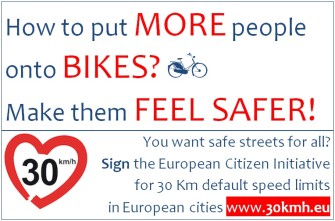
20mph speed limits quickly becoming a reality in London
 The Mayor of London’s Roads Task Force has acknowledged the importance of speed limits in London and surrounding Boroughs. This spells good news for cyclists and pedestrians who wish for safer, quieter, and less congested city roads.
The Mayor of London’s Roads Task Force has acknowledged the importance of speed limits in London and surrounding Boroughs. This spells good news for cyclists and pedestrians who wish for safer, quieter, and less congested city roads.
Simply put: Safer roads means safer cyclists. Safer cyclists means more cyclists. More cyclists means better roads. It is a cyclical process and every aspect can be promoted, as they are mutually inclusive.
One of the easiest and cheapest ways to make city roads safer for European cyclists and pedestrians is to reduce speed limits. The European Citizens’ Initiative “30kmh—making streets liveable” seeks to force the European Commission to looking into the possibility of making 30 kph the default speed in urban areas. The ECF has partnered with the initiative to focus on the cycling aspects of lower speed limits. Unfortunately, success has been slow going. However, just recently the 30kmh campaign’s UK partner 20’s Plenty For Us gained an important supporter.
The Mayor’s London Roads Task Force (RTF) recognized that “speed limits play an important role where ‘movement’ and ‘place’ need to be better balanced, where there are high levels of pedestrian activity and where safety issues have been identified” adding another success story to the ECI’s objective.
This recognition of speed limits’ significance in cities led the RTF to suggest that the Central Activities Zones (West End, The City, and Southbank) and central London should have 20mph limits. The RTF suggests further, that inner London Boroughs, especially residential areas and town centers should have a 20mph speed limit. Similarly, Transport for London (TfL), the local government body that covers most aspects of London’s transport system, has supported the project and will continue to fund 20mph zones and implement trial areas through 2021 in London Boroughs and more centralized locations like the Waterloo IMAX roundabout.
TfL’s delivery program for the RTF has already heavily benefited 20’s Plenty. In fact, 25% of London Boroughs have already agreed to 20mph limits. “London has come a long way on slower speeds this year” says 20’s Plenty London coordinator Jeremy Leach.
This recent support is great news and brings a lot of awareness to the growing campaign. 20’s Plenty Founder and Campaign Director Rod King MBE commented, “20 mph is the right speed limit for most urban streets. Many of our most iconic cities have already adopted this initiative and it’s great to see the Task Force recommending this for London too.”
Having support at city level is a great asset for the ECI and will hopefully encourage more city officials to take on the cause as well. But this is still on a local level. The ECI calls for EU wide 30kmh speed limits in cities and it needs signatures. Progressing the ECI would mean a greater chance for all EU cities to reap the benefits of lower speed limits not just on a city-by-city basis.
What are the benefits for cyclists?
For cyclists and those who want to cycle but are hesitant, reducing speed limits encourages more cycling. It does not only make the roads look safer, they actually are safer. A Norwegian study found that 10% decrease in the average speed would result in a 37.8% reduction in fatalities[i]. The city of Graz, Austria which was the first city to implement 30kmh speed limits had a 24% decrease in serious accidents after just 6 months[ii].
By making cycling and walking more enticing there is a shift in the modal share away from cars thereby placing more cyclists on the road providing greater safety in numbers. Perhaps these recent changes in London speed limits explain their current cycling boom[iii].
City roads should not be hazards dominated by buzzing cars that discourage physical activity. They should be open and safe for everyone and anyone, cars, cyclists, and pedestrians alike. By presenting the 30kmh ECI to the Commission there is a higher chance of citizens receiving added safety in cities.
Make your voice heard and sign the ECI here.
And for more information about the Roads Task Force and Transport for London click here
[i] Elvik, R et al (2004) Speed and road accidents: an evaluation of the Power Model https://www.toi.no/getfile.php/Publikasjoner/T%D8I%20rapporter/2004/740-2004/740-2004.pdf
[ii] Manfred Hoenig, The Graz traffic calming model and its consequences for cyclists, 2000, Department of transportation, City Council Graz http://www.velomondial.net/velomondiall2000/PDF/HONIG.PDF
[iii]http://www.standard.co.uk/news/london/move-over-amsterdam-the-london-cyc...
About the Author
Gregory Markus is a Communications Assistant at the ECF. He just received his Masters in European Studies from the University of Amsterdam. He currently lives in Amsterdam and is learning how to ride his bike no-handed.
- Log in to post comments
Contact the author
Recent news!
Upcoming events
Contact Us
Avenue des Arts, 7-8
Postal address: Rue de la Charité, 22
1210 Brussels, Belgium










